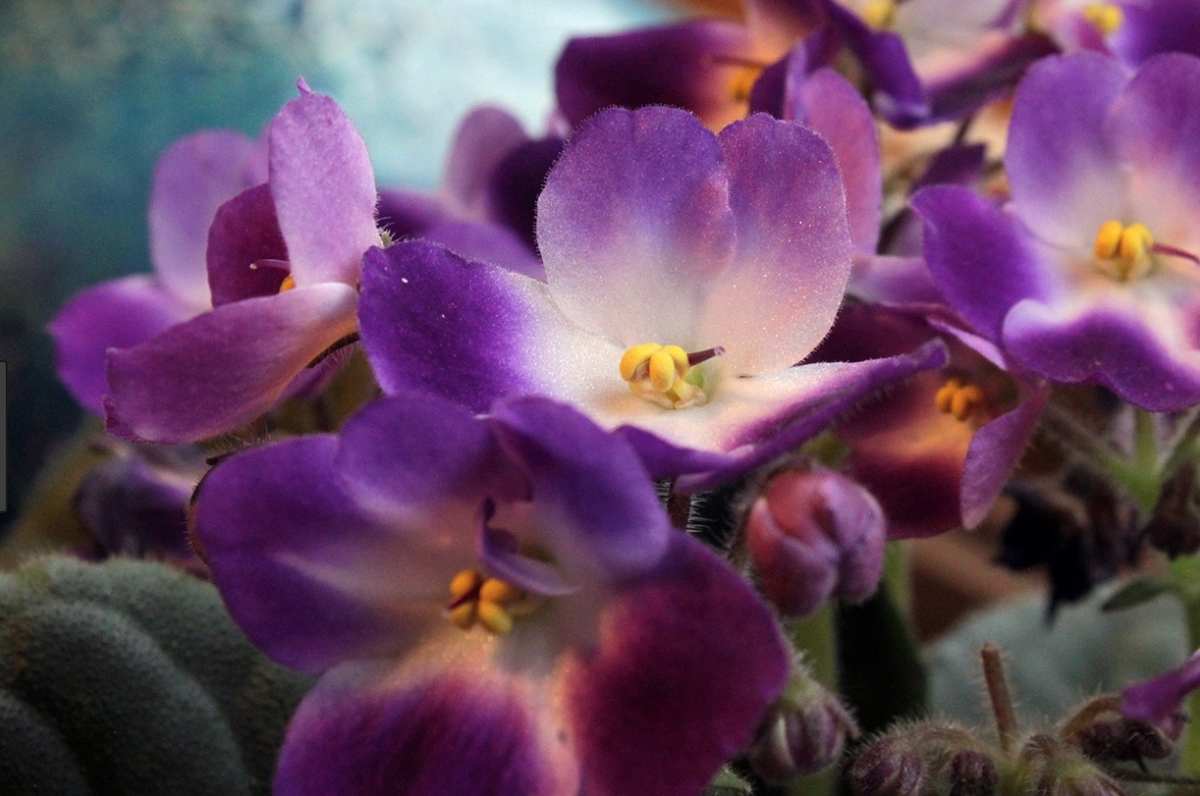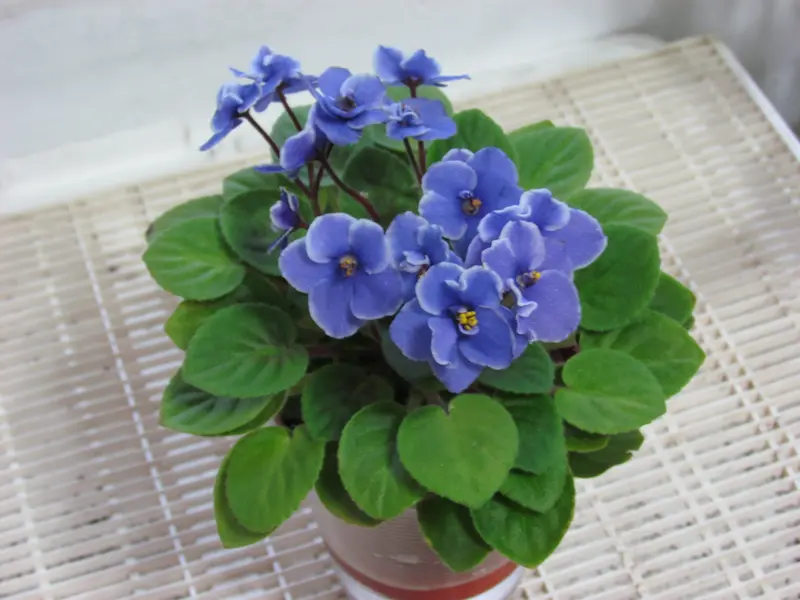African Violet Care and Propagation

African violets, botanical name Saintpaulia, add colour to any space in winter, and their cheerful flowers make us smile. Since African violets can be picky about where they want to be and how they want to be watered, we created a care guide for you.
The Basics
How do I pick the perfect African violet?
Select a healthy African violet of your choice of colour that has dark green, spot-free leaves. Look for a plant with one growing center, known as a single crown, to get the most blooms.
Quick Growing Guide
Botanical Name: Saintpaulia ionantha
Genus: Saintpaulia
En français: Violette africaine
Sun / Shade:
Water: Use lukewarm water
Width:
What container should I use?
Keep in mind that the roots grow out, not down, so a shallow wide container works better than a narrow tall container.
What potting soil should I use?
Choose an organic potting soil made specifically for African violets such as Espoma Organic African Violet Mix.
How much light should my African violet get?
African violets need indirect sunlight, as direct sunlight can burn the leaves. Choose a north- or east-facing window to keep plants away from cold glass. Rotate the pot once a week so all the leaves receive light. Extend daylight by placing African violets under a growing light during the winter months.
Do my African violets need to stay warm?
African violets prefer the same temperatures as most people find comfortable: between 70-80°F (low to mid 20sC) during the day, and around 65–70°F (High teens or 20C) at night.
How do I water my plant so it is happy?
Only water your violet when the soil is dry to the touch. Fill the pot’s saucer, and allow the roots to absorb the amount of water they need. After an hour, dump any remaining water to avoid overwatering.
When Should I fertilize?
In the spring, summer, and fall, fertilize about every 4 weeks. Consider using a special African Violet fertilizer such as with Espoma’s Violet! indoor houseplant food

Getting Leggy
What causes my African violet to get leggy?
Leggy is when new growth forms on a plant tip. This new growth takes most of the energy away from the bottom of the plant. The three main reasons why your plant is getting leggy are:
Age
The lower leaves of African violets will turn yellow and finally fall off the plant, leaving other stalks barren. Plants lose the rosette of leaves at the base as a normal aspect of ageing. This, too, can give the plant a leggy appearance.
Water
African violet leaves dislike being wet, which makes them susceptible to mildew, rot, and fungus. The blossoms will grow leggy in response to the mildew or fungus. The soil should be well-draining so that it may dry between waterings. Always water the soil instead of the plant.
Light
African violets require bright, indirect light, which can be provided by grow lights or by positioning the plant near a thin curtained window. When you deprive your plant of light, it will produce longer stems as it reaches for light to grow.
What can I do to help my leggy plant?
Make sure the plant is getting the correct amount of light and water. If everything else fails, try repotting your African violet. Giving your plant more room for roots and a healthier growth environment can help it thrive.
Repotting African Violets
How often should I repot my African violet?
Once a year should be enough to keep your plant happy. It will provide new space for root growth and also prevent it from getting leggy.
Can I use the same size container?
You want to find a slightly bigger container than the one it is in now – never smaller. While African violets like to be root bound to bloom, you want to provide space for them to breathe and grow.
Can I reuse the soil?
It’s best to start fresh with organic potting soil made specifically for African violets such as Espoma Organic African Violet Mix. Using the same soil can bring new infestations to your plants that may not be prevalent now.
How close to the top of the pot should the root ball be?
You want the root ball to be below the top of the container. Don’t forget to center your plant!
Do I need to compact the plant in the new pot?
It is best to tuck your plant into the new pot gently. Pressing too hard can harm the leaves, but not tucking them in can cause problems in growth. Settle the plant by watering it from the saucer.
Propagating African Violet
Is it difficult to propagate African violets?
Absolutely not! It’s one of the simplest plants to grow. Their upkeep is simple, and they propagate easily via division or leaf cuttings. However, leaf cutting propagation is probably the most common. When selecting a leaf cutting, choose middle-sized leaves, cut them with about an inch of leaf stem (called the petiole). To speed the rooting process, dust the cut end in hormone powder.
Propagating From Leaf Cuttings
The two most practical methods for rooting divisions or leaf cuttings are to place the African violet plants in either soil or water. Choose a healthy leaf on one of your existing plants. Before planting it in your soil, make sure it has a clean cut. See here for detailed instructions.
Propagating in Water
Prepare a clear glass, a transparent plastic jar, or plastic pots with a wider top than its bottom part to provide the best conditions for the leaves. This will permit you to easily monitor the water and root. If you have any doubts about the water’s purity, boil it for three minutes and let it cool before using. Warm and cold water will both harm the young roots. Wrap wax paper around a water-filled glass tumbler or mason jar and secure it with a rubber band. Pierce the paper three times. Insert the leaf stems into these holes, deep enough to allow the stems to reach the water. Set the glass or jar in indirect light or a by sunny window where they will receive roughly the same amount of light as your growing plants. You can also root plants with fluorescent grow lights.
At about 3-4 weeks, roots should begin forming on the leaf. Then, change the water. In another 2-4 weeks, your new leaves will start to sprout. When the leaves of plantlets have unfolded and the pot plants are about an inch tall, transplant the cuttings into soil. To protect the new plants from shock, wrap them in transparent plastic bags (or use plastic bottles). After six weeks, the plants can be transferred to three-inch pots and given regular African violet care. You can let them flower in these pots and then transplant them into four-inch pots as they mature.
Propagating in Soil
To start leaf cuttings or plant divisions in soil, use jars, pots, terrariums, aquariums; even plastic soda bottles as a makeshift greenhouse for propagation. In a potting soil media of moistened vermiculite, (50% bagged African violet soil potting mix and 50% perlite), insert the leaves just deep enough to escape the soil surface. Rot often starts when the leaves rest on it. Pack the soil mixture tightly around each stem. Keep the “mini greenhouse” away from direct sunlight. Over the top cover, a piece of cellophane secured with a rubber band. Little attention will be required over the next few weeks.
In the first few days after planting, check the soil to ensure that you moistened it sufficiently to keep it damp. If moisture accumulates on the sides of the glass, remove the cover for a short period of time to wipe away the excess and reduce humidity. Such care will be unnecessary in a room temperature and not so sunny location. The rooted leaves will be at the new-plant stage and ready for potting separately in four to six weeks.
Are African Violets Poisonous to Cats or Dogs?
The ASPCA (American Society for the Prevention of Cruelty to Animals) has determined that African Violet is non-toxic to cats, dogs and even horses. Nor are they poisonous to humans for that matter.
However, make sure you do not over-fertilize or add insecticides that might be poisonous.